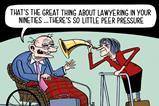Small Firms Division annual conference
Social media is ‘a room where a networking event is being held’. It is ‘a fast, easy and inexpensive way to communicate’. And it also ‘improves brand awareness and credibility’.
This eulogy to one of the newest ways to promote your practice comes from Julie Gingell, director of marketing and business development at St Albans firm SA Law.
So what could possibly go wrong? Addressing delegates to the Law Society Small Firms Division annual conference, Gingell gives two examples of good social media intentions precipitating unforeseen, potentially catastrophic consequences. Posting photographs of colleagues paying for items they have bought at charity auctions ostensibly sends out the right message. That message could backfire disastrously, however, if (as actually happened) colleagues’ credit card numbers and home addresses are visible.
Equally, by all means post photos snapped inside the office showing colleagues working conscientiously on client matters. But be careful not to include a file, innocently stacked on a shelf, with a client’s name written upon it. You’ll be in breach of data protection rules.
It is perhaps just such social media blunders that prompted two of the delegates at this year’s conference to state that social media had no part to play in their business. The wonder is there were not more people cynical about social media. After all, small firm owners have regulation, money laundering, marketing, data protection, cashflow, staffing and a myriad other issues to worry about. So why add to the stress by setting up on social media?
‘For all the reasons above,’ replies Gingell. ‘The only cost is time.’ She tells the conference about her firm’s social media successes. These include a blog serialising the trials and tribulations of fictional character Rebecca Green’s divorce. ‘Our aim is to dispel the myths around divorce,’ Gingell says. ‘The blog has been read on four continents and has now evolved into a book.’
But where do you start and how do you constantly come up with ideas for content? Gingell suggests: ‘Find your tribe online, follow key stakeholders, join groups and follow back anyone who follows you. As for content, make time in your working day for social media. Think about it during your commute or when waiting for the kettle to boil. Develop a content calendar so you can mark significant dates, events and anniversaries. And keep it simple, stupid.’
Panel discussion: business models
There is no common reason why lawyers take a leap into the unknown and set up as sole practitioners or start their own firms. Certainly, the three members of the Small Firms Division panel answering questions from the floor on how best to structure their practices had diverse motivations.
Solicitor-advocate Satpal Roth funded the founding of Yorkshire firm Kher Solicitors with money from a redundancy package. James Brown started his own firm Hall Brown, he tells us, because ‘too many baby boomers’ were occupying senior positions in his previous firm and were showing no inclination to move on. Yorkshire firm Roche Legal founder Rachel Roche’s inspiration came from being determined to develop an online will and lasting power of attorney programme.
The panel fields a variety of questions. When it comes to strategic decision-making, who sits at the top table as in a traditional law firm? Roche replies: ‘As a sole practitioner, it’s me making the decisions, but supported by a team of 30 giving best advice.’
Another delegate asks: How much time do you spend fee-earning and how much managing? ‘Starting your own firm is hard work,’ Brown responds. ‘My dreams of golf in the afternoons never became a reality. The business exploded and I didn’t see much of my children. I’ve now settled down to 50% management and 50% fee-earning. It’s not a matter of life and death. I’ve a photo of my grandfather standing before a Lancaster bomber. He’s going to bomb Germany from a tin can. In contrast, the worst I might get is a paper cut.’
Roth puts in: ‘You need to become a good manager overnight, even if you’re still working at the kitchen table. But you can’t go on working day and night. You need some sleep to keep on the ball. So rely on recommendations and talk to people.’
The panel and the floor are united on the wisdom of working with consultants. In addition to lending their experience, they also often bring clients and their grey hair gives gravitas to the often young owners of the fledgling business. But how do you remunerate self-employed consultants and ensure they toe the party line?
Brown explains that his firm pays consultants on a sliding scale of a fixed percentage if they do the work and a different percentage if they introduce the work and pass it on to a colleague.
Where conforming to the firm’s culture is concerned, a delegate avers: ‘How do you herd cats? Sometimes it’s best simply to move the cat food.’
Jonathan Rayner is contributing writer at the Gazette

































No comments yet